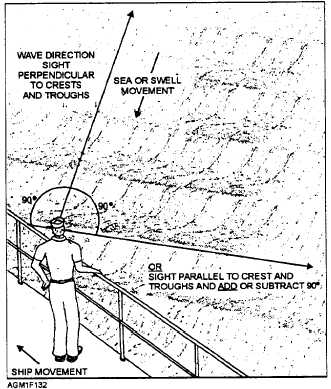the most accurate wave height estimations. This is
understandable since an observer on a carrier catwalk is
some 60 feet above the water line, and the waves look
small from that height. Estimation may be improved by
observing wave height from the hangar deck, which is
only some 30 feet above the water. Until the observer
becomes very experienced in observing wave heights,
reference objects should be used to judge the wave
height.
Good reference objects are ships-in-company or
small boats operating alongside. Waves may be
compared to the heights of the freeboard along the sides
of the ships, or to the size of the small boats. "Load line"
markings in feet may be visible on the sides of ships and
will assist in wave height determination. Be careful not
to observe the waves near the bow of a ship, since the
bow-wave is caused by the ship and is not a true
representation of the actual wave heights.
The best reference object is something of known
size. Some shipboard weather offices keep square 1-, 2-
, or 3-foot pieces of cardboard on hand to throw over the
side of the ship and use as a reference. Other ships use
1-foot-square pieces of scrap wood as a reference.
(Cardboard is preferable, since it will soon become
soggy, breakdown, and sink in the water, and it is
biodegradable. It is also readily available.) Using a
block of wood or cardboard as a reference is known as
the chip or block method.
Wave Length
Wave length is the horizontal distance from one
wave crest to the next wave crest, or the distance from
one wave trough to the next wave trough. Although
difficult to measure at sea, this parameter may be
measured on aerial photographs and is directly related
to wave period by the approximation L = 5.12T2 , where
L is the wavelength in feet and T is the wave period in
seconds. Wave lengths are not directly observed or
reported by observers.
Wave Period
Wave period is the time, usually measured in
seconds, that it takes for a complete wave cycle (crest to
crest or trough to trough) to pass a given fixed point.
Wave period is dependent upon the speed of movement
of the wave across the surface. The speed of movement
varies with wave length, with shorter wave-length
waves moving slower and longer wave-length waves
moving faster. This relationship is approximated by
C = 1.34
L, where C is the wave speed (knots) and L is
the wave length. Many calculations dealing with waves
use the wave frequency instead of the wave period as a
basis for the argument. The wave frequency is the
number of wave cycles passing a fixed point in 1
second, and it is inversely proportional to wave period.
Conversions between wave frequency ( f ) and wave
period(T) are made by the formula f= 1/T or T = 1/f.
Wave Direction
Wave direction is the direction, in true degrees of
azimuth, that the majority of the waves in a group are
coming from. Wave direction is best determined during
an observation by sighting along the wave crests and
troughs and either adding 90° to or subtracting it from
the direction obtained, as shown in figure 1-32. Use the
gyroscope repeater on one of the pelorus columns
(chapter 2, fig. 2-29) to sight along the wave crests or
troughs. Add or subtract 90° to/from the true bearing
thus obtained to determine the wave direction. The
observer may also sight directly into the oncoming
waves, perpendicular to the crests and troughs, to obtain
wave direction.
SEA WAVES
Sea waves, often referred to as "seas," are waves
generated by the wind in the local area. Light winds
Figure 1-32.—Method for obtaining wave direction.
1-47


